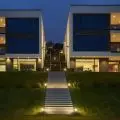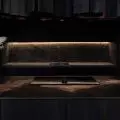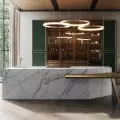An architectural laboratory that feels like a workshop. ME by Starck and Vero Air by Duravit emphasize minimalist aesthetics in sanitary areas.
Aarhus School of Architecture
© Duravit
"An architecture factory" - That's what Danish architecture firm ADEPT calls its Aarhus School of Architecture project, which was built on the site of a former freight warehouse. The raw aesthetics with concrete surfaces, steel stairs, visible pipes and an industrial-style glass facade are also expressed in the sanitary rooms: Behind pine doors and in front of square white tiles, the ME by Starck toilets designed by Philippe Starck blend in perfectly with the existing architecture and play their part in the minimalist aesthetic. As washbasins, the architects chose Vero Air washbasins in 60 and 120 cm sizes. Their striking, careful design delights with simple surfaces.
Aarhus School of Architecture
© Duravit
A living laboratory of architecture
The new Aarhus School of Architecture combines ten previous locations in a 12,500-square-meter building. The vision was for a robust structure otherwise a living laboratory of architecture that can be easily adapted to future requirements and needs.
This inspired a workshop-like design that presents itself as an anti-icon - a blank canvas for ideas, creativity and learning, explained Martin Krogh, partner at ADEPT.
As an experimental environment for students and teaching staff, the Aarhus School of Architecture also invites interaction with the neighborhood. This includes, for example, the "X Institute" adjacent to the school, an independent nonprofit cultural association that grew out of civic initiatives and sees itself as an open platform for culture, business and education.
Aarhus School of Architecture
© Duravit
Transparency, openness and flexibility
The Aarhus School of Architecture has a clear and open exterior: a concrete superstructure defines the screened facade, which consists of large glass surfaces. Inside, too, visible structural elements define the building's appearance. The superstructure consists of spacious building blocks, arranged like a checkerboard, which house workshops, lecture halls, as well as restrooms, storage and technical rooms. Air spaces are cut into the block, which break up the building in the vertical plane. Free space flows around the "blocks" and air spaces, individual work areas conceived as flexible spaces onto which various uses can be projected. Two large roof terraces on the second and third floors and one smaller one on the second floor emerge from the layered cubes of the building. A striking feature is the school library located in the northwest section. It has been placed in a space spanning three floors - a load-bearing structure within a load-bearing structure. As a raw wooden structure with tick-beam technique, its wooden surfaces exude a gentle homeliness.
Aarhus School of Architecture
© Duravit
Martin Krogh again:
The design allows interiors and exteriors to meld together, not only through literal transparency, but also by asking which spaces belong to the university and which belong to the city. This means that both the urban environment and the university will influence the building in the future.
For more information, visit the company's DURAVIT POLSKA Sp. z o.o. page on the A&B portal.




































